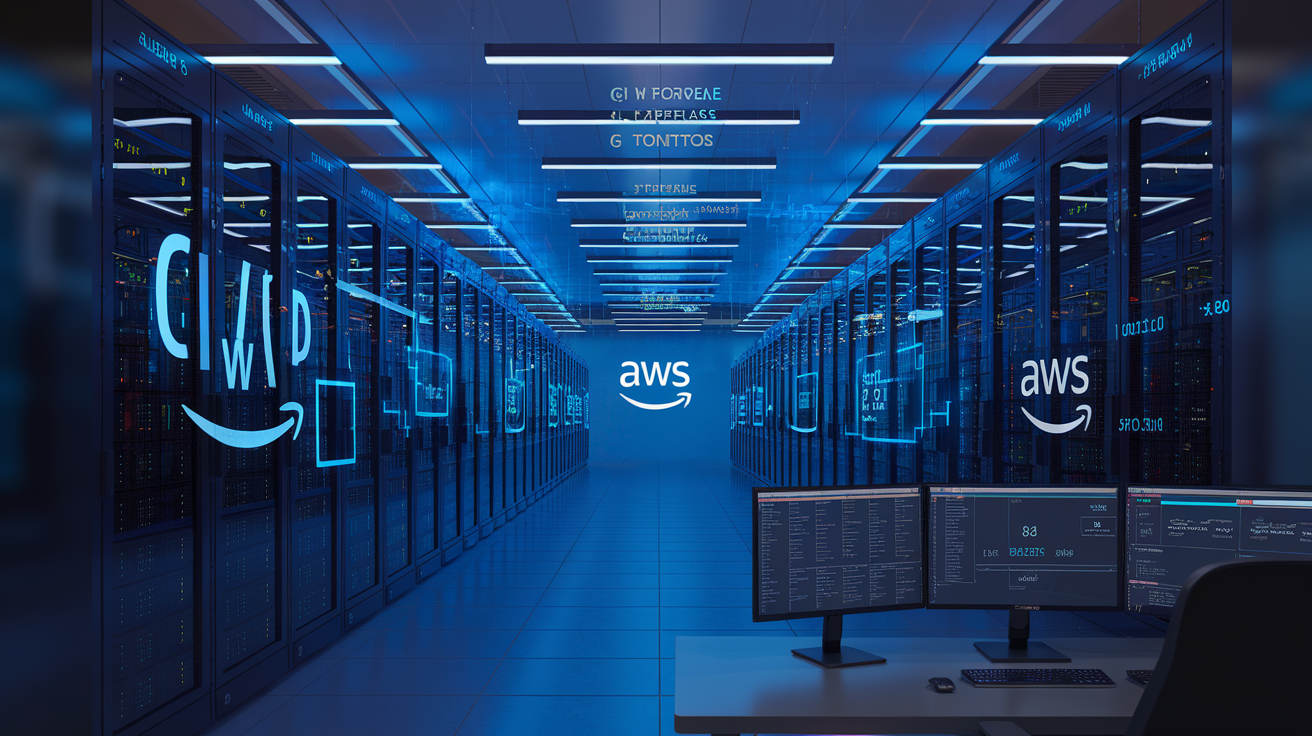Are you tired of slow, error-prone software releases? 🐌 Imagine a world where your development team deploys code seamlessly, frequently, and with confidence. That’s the power of a well-optimized CI/CD pipeline on AWS.
In today’s fast-paced tech landscape, continuous integration and continuous delivery (CI/CD) have become more than just buzzwords—they’re essential practices for staying competitive. But setting up and maintaining an efficient CI/CD pipeline on AWS can be challenging. From environment configuration to security concerns, there’s a lot to consider.
In this comprehensive guide, we’ll walk you through the best practices for CI/CD pipeline automation on AWS. We’ll cover everything from understanding the basics to scaling your pipeline for enterprise-level operations. Whether you’re just starting with AWS or looking to optimize your existing setup, you’ll find valuable insights to streamline your development process and boost your team’s productivity. Let’s dive in and explore how to master CI/CD on AWS! 💪🚀
Understanding CI/CD on AWS

Key components of CI/CD pipelines
CI/CD pipelines consist of several interconnected components that work together to automate software delivery. Here are the essential elements:
- Source Control Management (SCM)
- Build Automation
- Test Automation
- Deployment Automation
- Infrastructure as Code (IaC)
| Component | Description | AWS Service |
|---|---|---|
| SCM | Manages code versions and collaborations | AWS CodeCommit |
| Build Automation | Compiles code and creates artifacts | AWS CodeBuild |
| Test Automation | Runs automated tests to ensure quality | AWS CodeBuild |
| Deployment Automation | Deploys code to target environments | AWS CodeDeploy |
| IaC | Manages infrastructure through code | AWS CloudFormation |
Benefits of CI/CD automation
Implementing CI/CD automation on AWS offers numerous advantages:
- Faster time-to-market
- Improved code quality
- Reduced manual errors
- Increased team productivity
- Enhanced collaboration
- Consistent and repeatable processes
- Easier rollbacks and recovery
AWS services for CI/CD implementation
AWS provides a comprehensive suite of services for building robust CI/CD pipelines:
- AWS CodePipeline: Orchestrates the entire CI/CD workflow
- AWS CodeCommit: Managed source control service
- AWS CodeBuild: Fully managed build service
- AWS CodeDeploy: Automates application deployments
- AWS CodeStar: Unified interface for managing software development projects
These services integrate seamlessly, allowing developers to create efficient and scalable CI/CD pipelines tailored to their specific needs. By leveraging these AWS tools, teams can significantly improve their software delivery process and focus on building innovative features rather than managing infrastructure.
Setting Up Your AWS Environment

Configuring IAM roles and permissions
When setting up your AWS environment for CI/CD pipeline automation, configuring IAM roles and permissions is crucial. Start by creating a dedicated IAM role for your pipeline with the principle of least privilege. This ensures that your pipeline has only the necessary permissions to perform its tasks.
Key considerations for IAM configuration:
- Create separate roles for different stages of your pipeline
- Use AWS-managed policies where possible
- Implement custom policies for specific requirements
- Regularly audit and review permissions
Creating a dedicated VPC
A dedicated Virtual Private Cloud (VPC) provides isolation and security for your CI/CD infrastructure. Here’s a comparison of VPC configurations:
| Configuration | Pros | Cons |
|---|---|---|
| Default VPC | Easy setup | Less control |
| Custom VPC | Full control | More complex |
| VPC Peering | Connect multiple VPCs | Increased management |
Selecting appropriate EC2 instances
Choose EC2 instances that match your workload requirements. Consider factors such as:
- Instance type (compute-optimized, memory-optimized, etc.)
- Scaling capabilities (auto-scaling groups)
- Cost-effectiveness (spot instances for non-critical tasks)
- Performance needs (CPU, memory, storage)
Implementing security best practices
Secure your CI/CD environment by implementing AWS security best practices:
- Enable AWS CloudTrail for auditing
- Use AWS Config for compliance monitoring
- Implement encryption at rest and in transit
- Regularly patch and update your instances
With these foundational elements in place, you’re ready to design an efficient CI/CD pipeline on AWS. The next section will delve into the specifics of pipeline design, including tool selection and workflow optimization.
Designing an Efficient CI/CD Pipeline

A. Choosing the right AWS CI/CD tools
When designing an efficient CI/CD pipeline on AWS, selecting the appropriate tools is crucial. AWS offers a range of services tailored for CI/CD automation. Let’s compare some of the most popular options:
| AWS Service | Primary Use | Key Features |
|---|---|---|
| CodePipeline | Orchestration | Seamless integration, visual workflow |
| CodeBuild | Build & Test | Fully managed, customizable environments |
| CodeDeploy | Deployment | Multi-platform support, rollback capabilities |
| CodeCommit | Source Control | Secure, scalable Git repositories |
For most AWS-centric pipelines, a combination of these services provides a robust solution. CodePipeline acts as the backbone, orchestrating the entire process, while CodeBuild handles compilation and testing. CodeDeploy manages the deployment phase, and CodeCommit can serve as your source repository.
B. Integrating source control management
Effective source control management is the foundation of any CI/CD pipeline. AWS CodeCommit offers a seamless integration with other AWS services, but you can also use popular alternatives like GitHub or Bitbucket. Key considerations include:
- Version control system (Git is widely preferred)
- Branch management strategy (e.g., GitFlow, trunk-based development)
- Pull request and code review processes
- Integration with issue tracking systems
Remember to configure webhooks or polling mechanisms to trigger your pipeline automatically when changes are pushed to the repository.
C. Implementing automated testing
Automated testing is crucial for maintaining code quality and catching issues early. In your AWS CI/CD pipeline, consider implementing:
- Unit tests
- Integration tests
- Functional tests
- Performance tests
- Security scans
Utilize AWS CodeBuild to create separate build projects for different types of tests. This allows for parallel execution and faster feedback. Additionally, consider using AWS Device Farm for mobile app testing if applicable.
D. Configuring build and deployment stages
Optimizing Pipeline Performance

Parallelizing pipeline stages
Parallelizing pipeline stages is a crucial strategy for optimizing CI/CD performance on AWS. By executing multiple stages concurrently, you can significantly reduce overall build and deployment times. Here’s how to implement this effectively:
- Identify independent stages
- Configure parallel execution in AWS CodePipeline
- Balance resource allocation
| Stage Type | Parallelization Benefit |
|---|---|
| Build | High |
| Test | Very High |
| Deploy | Moderate |
Utilizing caching strategies
Implementing caching can dramatically speed up your pipeline by reusing previously fetched or computed data. Consider these caching techniques:
- Dependency caching: Store libraries and packages
- Build output caching: Save compiled artifacts
- Docker layer caching: Reuse container layers
Implementing incremental builds
Incremental builds focus on processing only the changes since the last successful build, significantly reducing build times. To implement:
- Use build tools that support incremental builds (e.g., Gradle, Bazel)
- Configure your pipeline to track and analyze changes
- Ensure proper cache invalidation for accurate incremental builds
Leveraging AWS serverless technologies
AWS serverless technologies can enhance pipeline performance and scalability. Key benefits include:
- Automatic scaling
- Pay-per-use pricing
- Reduced operational overhead
Consider integrating these AWS serverless services:
- AWS Lambda for running tests and scripts
- Amazon ECS on Fargate for containerized builds
- AWS Step Functions for complex workflow orchestration
By implementing these optimization strategies, you’ll significantly improve your CI/CD pipeline’s performance on AWS. Next, we’ll explore crucial security measures to protect your optimized pipeline.
Ensuring Pipeline Security

A. Implementing secrets management
When it comes to CI/CD pipeline security, implementing robust secrets management is crucial. AWS provides several tools to help manage and secure sensitive information:
- AWS Secrets Manager: This service allows you to easily rotate, manage, and retrieve database credentials, API keys, and other secrets throughout their lifecycle.
- AWS Systems Manager Parameter Store: A secure, hierarchical storage for configuration data management and secrets management.
Here’s a comparison of these two services:
| Feature | AWS Secrets Manager | AWS Systems Manager Parameter Store |
|---|---|---|
| Automatic rotation | Yes | No |
| Integration with other AWS services | Extensive | Limited |
| Cost | Pay per secret stored and API call | Free for standard parameters |
| Encryption | Default | Optional |
B. Scanning for vulnerabilities
Regularly scanning your pipeline for vulnerabilities is essential to maintain a secure CI/CD process. Implement the following practices:
- Use AWS CodeBuild to integrate vulnerability scanning tools into your pipeline
- Leverage Amazon Inspector for automated security assessments
- Implement static code analysis tools to catch security issues early in the development process
C. Enforcing least privilege access
Adhering to the principle of least privilege is crucial for pipeline security. Use AWS Identity and Access Management (IAM) to:
- Create fine-grained IAM roles for each stage of your pipeline
- Regularly audit and review permissions
- Implement temporary credentials using AWS Security Token Service (STS)
D. Encrypting data in transit and at rest
Ensure all data within your CI/CD pipeline is encrypted:
- Use AWS Key Management Service (KMS) to manage encryption keys
- Enable encryption for Amazon S3 buckets storing pipeline artifacts
- Utilize AWS Certificate Manager for SSL/TLS certificates to secure data in transit
By implementing these security measures, you’ll significantly enhance the overall security posture of your CI/CD pipeline on AWS.
Scaling Your CI/CD Pipeline

Utilizing Auto Scaling groups
Auto Scaling groups are crucial for maintaining optimal performance and cost-efficiency in your CI/CD pipeline. They automatically adjust the number of EC2 instances based on demand, ensuring your pipeline can handle varying workloads without manual intervention.
Key benefits of Auto Scaling groups:
- Improved availability
- Cost optimization
- Automatic scaling
- Self-healing capabilities
| Feature | Description |
|---|---|
| Target tracking scaling | Maintains a specific metric at a target value |
| Step scaling | Increases or decreases capacity based on specified thresholds |
| Scheduled scaling | Adjusts capacity based on predictable load changes |
Implementing blue-green deployments
Blue-green deployments minimize downtime and risk by running two identical production environments. This strategy allows for seamless updates and quick rollbacks if issues arise.
Steps for blue-green deployment:
- Create a clone of the current production environment (blue)
- Deploy updates to the new environment (green)
- Route a small portion of traffic to the green environment
- Gradually increase traffic to the green environment
- Once verified, switch all traffic to the green environment
- Keep the blue environment as a backup for quick rollback
Adopting canary releases
Canary releases offer a more gradual approach to deployment, reducing risk by exposing new features to a subset of users before full rollout.
Benefits of canary releases:
- Early detection of issues
- Controlled exposure to new features
- Reduced impact of potential failures
- Ability to gather user feedback
Leveraging AWS global infrastructure
Utilizing AWS’s global infrastructure allows you to scale your CI/CD pipeline across regions, improving performance and reducing latency for global teams and users.
Key considerations:
- Use Amazon CloudFront for content delivery
- Implement multi-region deployments
- Utilize AWS Global Accelerator for routing traffic
- Leverage AWS Transit Gateway for network connectivity
By implementing these scaling strategies, you can ensure your CI/CD pipeline remains efficient, resilient, and capable of handling increased workloads as your organization grows. Next, we’ll explore how to effectively monitor and continuously improve your pipeline to maintain peak performance.
Monitoring and Continuous Improvement

Setting up CloudWatch alarms
To effectively monitor your CI/CD pipeline on AWS, setting up CloudWatch alarms is crucial. These alarms provide real-time notifications about pipeline performance and potential issues. Here’s a table outlining key metrics to monitor:
| Metric | Description | Recommended Threshold |
|---|---|---|
| Pipeline Execution Time | Total time for pipeline completion | > 30 minutes |
| Build Failures | Number of failed builds | > 2 in 24 hours |
| Deployment Failures | Number of failed deployments | > 1 in 24 hours |
| Code Quality Score | Static analysis results | < 80% |
Configure these alarms using AWS CloudWatch console or AWS CLI for automated monitoring.
Analyzing pipeline metrics
Regular analysis of pipeline metrics helps identify bottlenecks and areas for improvement. Key metrics to focus on include:
- Build duration
- Test coverage
- Deployment frequency
- Mean time to recovery (MTTR)
Use AWS CloudWatch Dashboards to visualize these metrics and spot trends over time.
Conducting regular audits
Periodic audits of your CI/CD pipeline ensure its continued efficiency and security. Implement a checklist for audits:
- Review access permissions
- Check for outdated dependencies
- Verify test coverage
- Assess pipeline structure and stages
- Evaluate cost optimization opportunities
Implementing feedback loops
Feedback loops are essential for continuous improvement. Implement the following:
- Automated notifications for pipeline events
- Post-deployment surveys for stakeholders
- Regular team retrospectives on pipeline performance
By consistently monitoring and improving your CI/CD pipeline, you can ensure its effectiveness and reliability over time. This proactive approach helps maintain a high-quality, efficient development process on AWS.

Implementing CI/CD pipeline automation on AWS can significantly enhance your software development and deployment processes. By following best practices such as setting up a robust AWS environment, designing an efficient pipeline, optimizing performance, and ensuring security, you can create a streamlined and reliable CI/CD workflow. Scaling your pipeline and implementing continuous monitoring further contribute to the overall effectiveness of your DevOps practices.
To maximize the benefits of CI/CD automation on AWS, start by assessing your current infrastructure and identifying areas for improvement. Gradually implement these best practices, focusing on one aspect at a time. Remember that CI/CD is an iterative process, and continuous improvement is key to staying ahead in the fast-paced world of software development. By embracing these strategies, you’ll be well-equipped to deliver high-quality software faster and more efficiently than ever before.



















